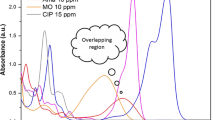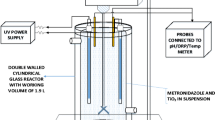Abstract
This work sought to study the elimination of nevirapine (NVP) from synthetic wastewater using the UV/TiO2/H2O2 system. The main objectives were to evaluate the influence of operating parameters, reaction kinetics, contributing reactive species, degradation pathway, and catalyst reusability. The research surface methodology (RSM) was utilized for optimizing process variables. Five process variables (pH, NVP concentration, TiO2 dosage, H2O2 concentration, and irradiation time) were optimized with the responses set as NVP and Total organic carbon (TOC) removals (%), respectively. 89.23% NVP and 85.71% TOC removals were achieved after 60 min of irradiation under optimum conditions. All the experimental factors were significant for NVP removal. pH was the most dominant factor, with the highest removals obtained under acidic conditions (pH 3). NVP removal conformed to the pseudo-first-order model with a rate constant (k1) of 0.03676 min− 1. Increasing pH reduced the rate constant by 75.38%, while there was an increase of 43.55% with H2O2. NVP degradation was primarily driven by the •OH and h+VB. The photocatalyst demonstrated good stability against NVP loss over four cycles. Although the UV/TiO2/H2O2 process has shown promising results in removing pharmaceuticals and dyes in wastewater, its application for the degradation of ARVs remains limited. As far as the authors know, the UV/TiO2/H2O2 process and RSM have not yet been reported for the degradation and optimization of NVP in wastewater, respectively. The findings of this work illustrate that the UV/TiO2/H2O2 system, applied with RSM optimization, can effectively degrade and mineralize NVP in wastewater.
Highlights
• The degradation of NVP in wastewater was evaluated using the UV/TiO2/H2O2 hybrid system.
• 89.23% nevirapine and 85.71% TOC removals were achieved.
• Maximum nevirapine removal was achieved at acidic pH of 3.
• Nevirapine removal adhered to pseudo-first-order kinetics with k1 of 0.0368 min− 1.
• The degradation process was controlled by •OH and h+VB.










Similar content being viewed by others
Data Availability
The datasets generated during and/or analyzed during the current study are available from the corresponding author on reasonable request.
References
Abafe OA, Späth J, Fick J, Jansson S, Buckley C, Stark A, Pietruschka B, Martincigh BS (2018) LC-MS/MS determination of antiretroviral drugs in influents and effluents from Wastewater treatment plants in KwaZulu-Natal South Africa. Chemosphere 200:660–670
Adeola AO, de Lange J, Forbes PBC (2021) Adsorption of antiretroviral drugs Efavirenz and Nevirapine from Aqueous Solution by Graphene wool: kinetic equilibrium thermodynamic and computational studies. Appl Surf Sci Adv 6:100157
Adeola AO, Forbes PBC (2022) Antiretroviral drugs in African surface waters: Prevalence analysis and potential remediation. Environ Toxicol Chem 41:247–262
Almaguer MA, Cruz YR, da Fonseca FV (2021) Combination of advanced oxidation processes and microalgae aiming at recalcitrant wastewater treatment and algal biomass production: A review. Environ Process 8:483–509. https://doi.org/10.1007/s40710-020-00492-x
Archer E, Petrie B, Kasprzyk-Hordern B, Wolfaardt GM (2017) The Fate of Pharmaceuticals and Personal Care Products (PPCPs) endocrine disrupting contaminants (EDCs) metabolites and illicit drugs in a WWTW and environmental waters. Chemosphere 174:437–446
Bhembe YA, Lukhele LP, Hlekelele L, Ray SS, Sharma A, Vo D-VN, Dlamini LN (2020) Photocatalytic degradation of Nevirapine with a heterostructure of few-layer Black Phosphorus coupled with Niobium (V) Oxide Nanoflowers (FL-BP@ Nb2O5). Chemosphere 261:128159
Clinical Info HIV.org. (n.d.). Drug database: Nevirapine. https://clinicalinfo.hiv.gov/en/drugs/nevirapine/patient. Accessed 22 Nov 2022
Collivignarelli MC, Abbà A, Miino MC, Arab H, Bestetti M, Franz S (2020) Decolorization and biodegradability of a Real Pharmaceutical Wastewater treated by H2O2-Assisted photoelectrocatalysis on TiO2 meshes. J Hazard Mater 387:121668
Coutts J, Hintze P, Meier A, Devor R, Surma J, Maloney P, Bauer B, Shah M, Mazyck D (2016) Visible-light-responsive photocatalysis: Ag-Doped TiO2 catalyst development and reactor design testing. 46th International Conference on Environmental Systems, 69. Vienna, Austria
Cuerda-Correa EM, Domĺnguez-Vargas JR, Muñoz-Peña MJ, González T (2016) Ultraviolet-photoassisted advanced oxidation of parabens catalyzed by hydrogen peroxide and titanium dioxide improving the system. Ind Eng Chem Res 55:5152–5160. https://doi.org/10.1021/acsiecr5b04560
Dissanayake M, Senthuran S, Senadeera GKR (2020) Efficiency enhancement in dye-sensitized solar cells using hierarchical TiO2 Submicron size spheres as a light scattering layer. J Solid State Electrochem 24:2261–2269
Fast SA, Gude VG, Truax DD, Martin J, Magbanua BS (2017) A critical evaluation of advanced oxidation processes for emerging contaminants removal. Environ Process 4:283–302. https://doi.org/10.1007/s40710-017-0207-1
Gualtieri AF, Gatta GDi, Arletti R, Artioli G, Ballirano P, Cruciani G, Guagliardi A, Malferrari D, Masciocchi N, Scardi P (2019) Quantitative phase analysis using the rietveld method: Towards a procedure for checking the reliability and quality of the results. Period Mineral 88:147–151. https://doi.org/10.2451/2019PM870
Hidayah N, Idris M, Yew K, Kennedy BJ, Ohno T, Ling H (2022) Buoyant titanium dioxide (TiO2) as high performance photocatalyst and peroxide activator : a critical review on fabrication, mechanism and application. J Environ Chem Eng 10:107549. https://doi.org/10.1016/j.jece.2022.107549
Khan TT, Rafiqul Bari GAKM, Kang HJ, Lee TG, Park JW, Hwang HJ, Hossain SM, Mun JS, Suzuki N, Fujishima A et al (2021) Synthesis of N-Doped TiO2 for efficient photocatalytic degradation of atmospheric NOx. Catalysts 11:1–13. https://doi.org/10.3390/catal11010109
Lei Y, Yang Y, Zhang P, Zhou J, Wu J, Li K, Wang W, Chen L (2021) Controllable one-step synthesis of mixed-phase TiO2 nanocrystals with Equivalent Anatase / Rutile ratio for enhanced photocatalytic performance. Nanomaterials 11:1347
Lumbaque EC, Sirtori C, Vilar VJP (2020) Heterogeneous photocatalytic degradation of pharmaceuticals in synthetic and real Matrices using a tube-in-tube membrane Reactor with Radial Addition of H2O2 Sci Total Environ 743:140629
Miklos DB, Remy C, Jekel M, Linden KG, Drewes JE, Hübner U (2018) Evaluation of advanced oxidation processes for water and wastewater treatment–A critical review. Water Res 139:118–131
Nagaraj G, Dhayal Raj A, Albert Irudayaraj A (2018) Next generation of pure titania nanoparticles for enhanced solar-light photocatalytic activity. J Mater Sci Mater Electron 29:4373–4381
Nannou C, Ofrydopoulou A, Evgenidou E, Heath D, Heath E, Lambropoulou D (2020) Antiviral drugs in aquatic environment and Wastewater treatment plants: a review on occurrence fate removal and ecotoxicity. Sci Total Environ 699:134322
Ngumba E, Gachanja A, Tuhkanen T (2020) Removal of selected antibiotics and antiretroviral drugs during post-treatment of municipal wastewater with UV UV/Chlorine and UV/Hydrogen peroxide. Water Environ J 34:692–703
Okoro JUAUC, Onukwuli LEAOD, Akpomie IOOKG (2019) Application of response surface methodology for optimization of dissolved solids adsorption by activated coal. Appl Water Sci 9:1–11. https://doi.org/10.1007/s13201-019-0943-7
Ouyang F, Li H, Gong Z, Pang D, Qiu L, Wang Y, Dai F, Cao G, Bharti B (2020) Photocatalytic degradation of industrial acrylonitrile wastewater by F–S–Bi–TiO2 catalyst of ultrafine nanoparticles dispersed with SiO2 under natural sunlight. Sci Rep 10:1–10
Pavlidis G, Tsihrintzis VA (2018) Environmental benefits and control of pollution to surface water and groundwater by agroforestry systems: A review. Water Resour Manag 32:1–29. https://doi.org/10.1007/s11269-017-1805-4
Phan Nguyen T, Ba Tran Q, Viet Ly Q, Thanh Hai L, Trung Le, Bao Tran M, Thanh Tam Ho T, Cuong Nguyen X, Shokouhimehr M, Vo D-VN et al (2020) Enhanced visible photocatalytic degradation of diclofen over N-doped TiO2 assisted with H2O2: A kinetic and pathway study. Arab J Chem 13:8361–8371. https://doi.org/10.1016/jarabjc202005023
PubChem National Library of Medicine (US) (n.d.) National center for biotechnology information PubChem compound summary for CID. Available online: https://pubchemncbinlmnihgov/. Accessed 7 Apr 2021
Rajh T, Dimitrijevic N (2008) Synthesizing mixed-phase TiO2 nanocomposites using a hydrothermal method for photo- oxidation and photoreduction related papers. J Catal 253:105–110. https://doi.org/10.1016/jjcat200710014
Rani CN, Karthikeyan S (2020) Feasibility study of acenaphthene degradation in a novel slurry UV photocatalytic membrane reactor: Effect of operating parameters and optimization using response surface modeling. Chem Eng Process - Process Intensif 155:108051. https://doi.org/10.1016/jcep2020108051
Rostami M, Hassani Joshaghani A, Mazaheri H, Shokri A (2021) Photo-degradation of P-Nitro Toluene using modified Bentonite based Nano-TiO2 photocatalyst in aqueous solution. Int J Eng 34:756–762
Runčevski T, Brown CM (2021) Half of a century anniversary cryst growth. Des 21:4821–4822. https://doi.org/10.1021/acscgd1c00854
Shokri A, Bayat A, Mahanpoor K (2019) Employing Fenton-like process for the remediation of petrochemical wastewater through Box–Behnken design method. Desalin Water Treat 166:135–143
Sornalingam K, Mcdonagh A, Zhou JL, Hasan A, Boshir M (2018) Photocatalysis of estrone in water and wastewater: Comparison between Au-TiO2 nanocomposite and TiO2 and degradation by-products. Sci Total Environ 610–611:521–530. https://doi.org/10.1016/jscitotenv201708097
Tafreshi N, Sharifnia S, Dehaghi SM (2019) Photocatalytic treatment of a multicomponent petrochemical wastewater by floatable ZnO / oak charcoal composite: Optimization of operating parameters. J Environ Chem Eng 7:103397. https://doi.org/10.1016/jjece2019103397
Thu A, Juang R (2015) Photocatalytic degradation of p -Chlorophenol by hybrid H2O2 and TiO2 in aqueous suspensions under UV irradiation. J Environ Manage 147:271–277
Tsihrintzis VA (2017) The use of vertical flow constructed wetlands in wastewater treatment. Water Resour Manag 31:3245–3270. https://doi.org/10.1007/s11269-017-1710-x
Verma P, Kumar J (2014) Degradation and microbiological validation of meropenem antibiotic in aqueous solution using UV UV/H2O2 UV/TiO2 and UV/TiO2/H2O2 processes. Int J Eng Res Appl 4:58–65
Wahyuni ET, Roto R, Sabrina M, Anggraini V, Leswana NF, Vionita AC (2017) Photodegradation of detergent anionic surfactant in wastewater using photodegradation of detergent anionic surfactant in wastewater using UV / TiO2 / H2O2 and UV / Fe2+ / H2O2. processes. Am J Appl Chem 24:174–180. https://doi.org/10.11648/jajac2016040513
Wang Q, Qiao Z, Jiang P, Kuang J, Liu W, Cao W (2018) Hydrothermal synthesis and enhance d photocatalytic activity of mixed-phase TiO2 powders with controllable anatase/rutile ratio. Solid State Sci 77:14–19
Acknowledgements
The authors wish to express their gratitude to the University of Johannesburg’s departments of Chemical Engineering and Applied Sciences for their research support. Our profound thanks go to S. Gbashi, E. Praba, and L. I. Fajimi, for their valuable contributions.
Author information
Authors and Affiliations
Contributions
The conception and design of the study were done by all the authors. Pauline Ncube performed material preparation, experiments, data collection, and analysis. The first draft of the manuscript was written by Pauline Ncube and proofread by Freeman Ntuli, Caliphs Zvinowanda, and Mohamed Belaid. All authors read and approved the final manuscript.
Corresponding author
Ethics declarations
Ethical Approval
This declaration is not applicable.
Competing Interests
The authors have no relevant financial or non-financial interests to disclose.
Additional information
Publisher’s Note
Springer Nature remains neutral with regard to jurisdictional claims in published maps and institutional affiliations.
Supplementary Information
Below is the link to the electronic supplementary material.
ESM 1
(DOCX 1.04 MB)
Rights and permissions
Springer Nature or its licensor (e.g. a society or other partner) holds exclusive rights to this article under a publishing agreement with the author(s) or other rightsholder(s); author self-archiving of the accepted manuscript version of this article is solely governed by the terms of such publishing agreement and applicable law.
About this article
Cite this article
Ncube, P., Zvinowanda, C., Belaid, M. et al. Heterogeneous Photocatalytic Degradation of Nevirapine in Wastewater Using the UV/TiO2/H2O2 Process. Environ. Process. 10, 1 (2023). https://doi.org/10.1007/s40710-022-00615-6
Received:
Accepted:
Published:
DOI: https://doi.org/10.1007/s40710-022-00615-6




